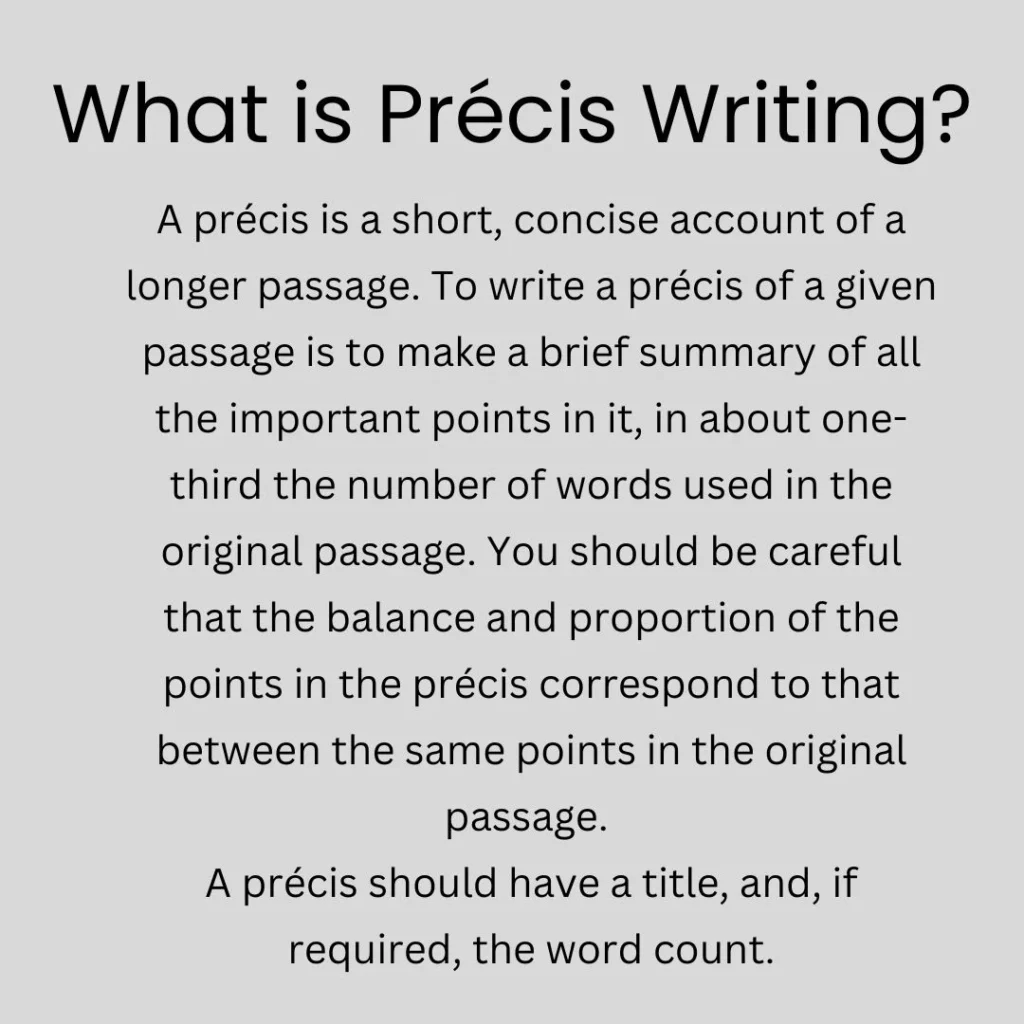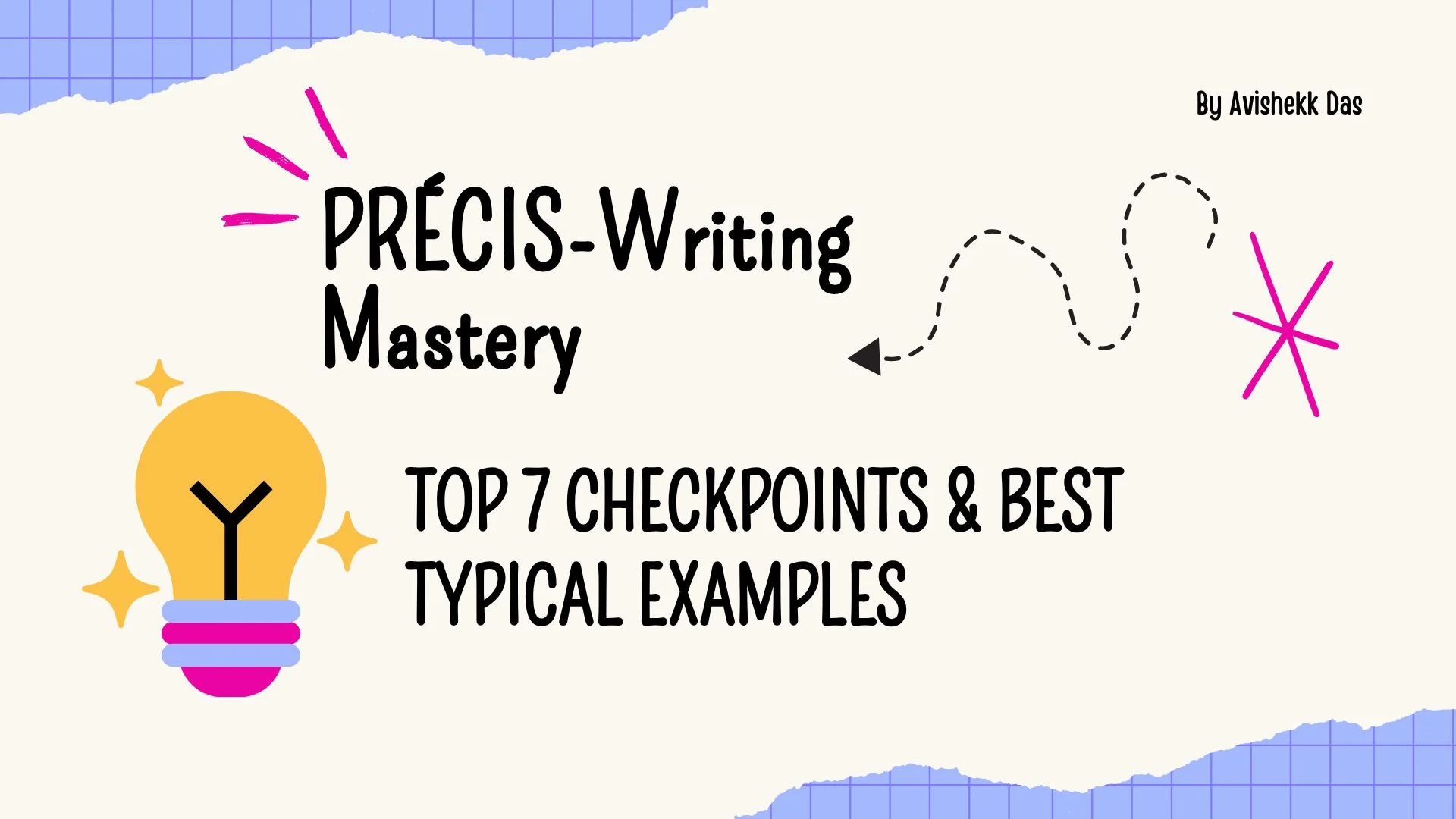PRÉCIS Writing Mastery with top 7 checkpoints and typical examples
What is Précis Writing?
A précis is a short, concise account of a longer passage. To write a précis of a given passage is to make a brief summary of all the important points in it, in about one-third the number of words used in the original passage. You should be careful that the balance and proportion of the points in the précis correspond to that between the same points in the original passage. A précis should have a title, and, if required, the word count.
To write a good Précis:
- Read the passage carefully at least twice.
- Write down all the important points in order. In a lengthy passage, write down the topic of each paragraph in a separate sentence. This will provide the framework of your précis.
- Try to present the facts in the same order as in the given passage unless you can improve the logical sequence through rearrangement.
- Try to avoid direct speech, repetition, over-explanation, ornamentation, and examples.
- Revise your précis so that all the important points are present in a logical order, and ensure that the essence of the original passage is retained.
- There is usually an instruction on the length of the précis — often in one of the three following forms — which should be carefully noted:
a) Write a précis of the passage in not more than ____ words means that a margin of ten words less than the number specified will be allowed.
b) Write a précis of the passage given in approximately ____ words means that a margin of five words on either side of the specified number will be allowed.
c) Write a précis of the passage within ____ to ____ words means that you should stick to the limits specified.
When trying to decide a title for the précis, ask yourself the question, What is the passage all about?

PRÉCIS Writing Example-1
Write a précis of the following passage in approximately one-third of its length, and add a suitable title to it.
The Mahayana teaches thus:
When the disciple considering an idea sees in him bad or unhealthy thoughts, thoughts of covetousness, hatred, or error, he should either turn his mind away from that idea, or concentrate it upon a healthy thought or else examine the fatal nature of the idea, or analyze it and decompose it into its different elements, or making appeal to all his strength and applying the greatest energy, suppress it from his mind; thus are removed and disappear these bad and unhealthy ideas and the mind becomes firm, calm, unified and full of vigor.
The Mother in The Lessons of Life [98 words]
Precis Writing Answer:-
Title: Means to eliminate unhealthy thoughts
Précis: The Mahayana instructs disciples who have unhealthy thoughts while considering an idea to think healthy thoughts, or else to ignore, dread, analyze, or resolutely suppress the idea, and acquire strength and serenity of mind. [34 words]
PRÉCIS Writing Example-2
In almost all ancient religions, we find that a special place is reserved for the Sun God. In Egypt, Ra was the chief of gods, the symbol of perfection. The Greeks had their Helios, while in Persia, the sun was the chief lieutenant of Ahura-Mazda in the struggle against darkness. (In the religions of the Incas the power accorded to the Sun, the son of the Creator Viracocha is attested by the centrality of the sun image in the artifacts discovered from South America.
In India, Surya was one of the most powerful deities in the early pantheon of gods, with his chariot that traversed the sky, pulled by seven horses. The famous temple at Konark is a testimony to the worship of the Sun). In traditional Japanese myths, there is Amaterasu, the rare Sun Goddess. Myths are usually dramatic and interesting ways of explaining and rationalizing the surroundings and circumstances of man’s existence, and in one sense all the early myths recognized and gave articulation to one basic fact: that the sun was the provider of life and energy on the earth.
The sheer amount of energy created by the sun is way beyond what most of us can imagine. The earth receives only a very small fraction of the entire energy generated by the sun. However, the energy received from the sun by the earth in one hour is more than the amount of energy consumed by the entire population of the world in one whole year!
Naturally, the free and constant flow of such a tremendous amount of energy has been the source of much speculation regarding the possibilities of utilizing or harnessing it for human use. Solar energy is used in traditional methods of drying grains, pottery, dyeing, food preservation, and other activities well-known to us. Even today in Indian households, the drying of pickles, papads, and other foodstuffs is commonplace. All these are methods of using the heat of the sun for domestic use.
Serious research began into the methods of harnessing solar energy during the Industrial Revolution as the possibilities and uses of various forms of energy multiplied manifold with the invention of machines of all kinds. There are reports of many devices like solar steam engines and pumps being operated in the nineteenth century. In Bombay, a solar steam Engine was patented by W. Adam in 1876. One of the most impressive uses of solar energy around this time was the construction of a huge water purification system in Chile in 1874 which purified 23,000 litres of water every day for 40 years.
The use of the first solar cooker is also recorded in this period. In 1837 Sir Herschel cooked vegetables and meat into a stew in a wooden solar stove embedded in sand. Samuel Pierpont Langley, the builder of the first plane to fly, also constructed a solar oven. The use of mirrors is first recorded in a stove made in Bombay in 1876 to cook meat and vegetables.
For various reasons, the enthusiasm regarding solar energy was dampened in the twentieth century as the consumption of energy per individual rose to unprecedented heights. Conventional fuels like coal, oil, and gas were mined and exploited with relative ease, and the story of solar energy was relegated to the background; though only for a while.
Today, once again, scientists are looking for ways of harnessing the sun’s immense power for the use of mankind, and the fruits of this research are being used by hundreds and thousands of people around the world.
(588 words)
This précis has been written following the guidelines given above.
Precis WritingAnswer:-
Title: The Sun as Father of Man
The sun, whether as the symbol of perfection or as the winner in the struggle against darkness, occupies a principal position as a divinity in most ancient religions. All these myths of the Sun God reflect an acknowledgment of the sun’s role as the source of life and energy on Earth.
An enormous amount of energy is generated by the sun. What the earth receives in one hour is greater than the energy needs of its entire population for a whole year. The availability of this huge amount of free energy generated speculation regarding the harnessing of solar energy for human needs.
Traditional household methods of dyeing fabrics and preserving foodstuff utilize the heat generated by the sun. Research into the possibility of harnessing solar energy was motivated during the Industrial Revolution. Solar steam engines, stoves, pumps, and even a solar water purification system were invented in several places around the world. However, in the twentieth century, human beings preferred coal, oil, and gas as the per-head consumption of energy increased tremendously, and solar energy was relegated to the background—though only temporarily. Today, scientists have again turned their attention to the utilization of the sun’s immense powers.
[198 words]
The précis has edited examples and over-explanation while retaining the same order of representing the facts. Unnecessary parts have been omitted. You should, however, be equally careful about retaining the important points. You should not change the argument or meaning of the original passage in any way.
PRÉCIS Writing Example-3
Bruno lived in England between 1583 and 1585. In this brief period, he created quite a sensation in intellectual circles: he lectured at Oxford and made friends with leading figures of the time, including Philip Sidney and the expatriate Italian philologist and translator John Florio. Bruno worked at a fantastic pace between early 1584 and the beginning of the next year, in the course of which he produced four or five major works, including the famous Expulsion of the Triumphant Beast.
Bruno lived as a guest in the household of the French ambassador to England, Michel de Castelnau (on the recommendation of no less a person than Henry III of France). There is nothing to suggest that Bruno was ever on bad terms with Castelnau: he dedicated books to him and left England with Castelnau when the latter retired. Apart from a bemused student who attended Bruno’s lectures and commented sarcastically on his Italianate Latin pronunciation, most people seem to have good things to say about Bruno.
Except, of course, his enemies in the church; they accused him of heresy and false teachings and attacking the pope. They then proceeded to burn him spectacularly at the Campo dei Fiori in Rome. That was in 1599, long after his sojourn in England.
(212 words)
Précis Writing Answer:-
Title: Bruno in England
In his brief sojourn in England, Bruno mixed in the highest of intellectual circles, lectured at Oxford, and composed four or five of his works. He was the guest of the French ambassador, to whom he dedicated books. Except for a single reference to his Italian Latin pronunciation, Bruno was universally praised in England. His only enemies were in the church—who burnt him, much later, as a heretic in Rome.
(72 words)
Practice Best 5 Precis Writing Samples with Answers
Best Gmp of IPO site

Wahhhhhhhhh good content